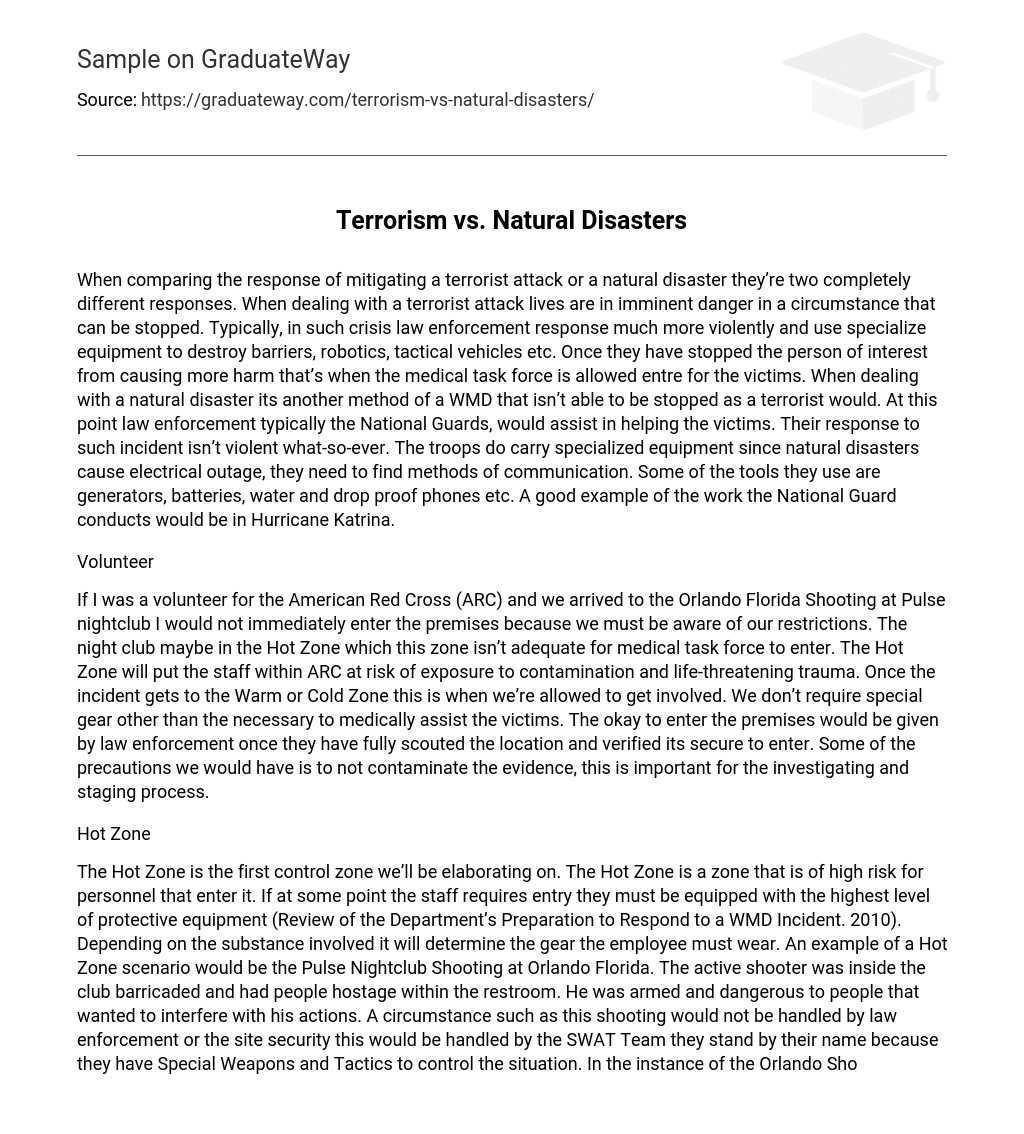When comparing the response of mitigating a terrorist attack or a natural disaster they’re two completely different responses. When dealing with a terrorist attack lives are in imminent danger in a circumstance that can be stopped. Typically, in such crisis law enforcement response much more violently and use specialize equipment to destroy barriers, robotics, tactical vehicles etc. Once they have stopped the person of interest from causing more harm that’s when the medical task force is allowed entre for the victims. When dealing with a natural disaster its another method of a WMD that isn’t able to be stopped as a terrorist would. At this point law enforcement typically the National Guards, would assist in helping the victims. Their response to such incident isn’t violent what-so-ever. The troops do carry specialized equipment since natural disasters cause electrical outage, they need to find methods of communication. Some of the tools they use are generators, batteries, water and drop proof phones etc. A good example of the work the National Guard conducts would be in Hurricane Katrina.
Volunteer
If I was a volunteer for the American Red Cross (ARC) and we arrived to the Orlando Florida Shooting at Pulse nightclub I would not immediately enter the premises because we must be aware of our restrictions. The night club maybe in the Hot Zone which this zone isn’t adequate for medical task force to enter. The Hot Zone will put the staff within ARC at risk of exposure to contamination and life-threatening trauma. Once the incident gets to the Warm or Cold Zone this is when we’re allowed to get involved. We don’t require special gear other than the necessary to medically assist the victims. The okay to enter the premises would be given by law enforcement once they have fully scouted the location and verified its secure to enter. Some of the precautions we would have is to not contaminate the evidence, this is important for the investigating and staging process.
Hot Zone
The Hot Zone is the first control zone we’ll be elaborating on. The Hot Zone is a zone that is of high risk for personnel that enter it. If at some point the staff requires entry they must be equipped with the highest level of protective equipment (Review of the Department’s Preparation to Respond to a WMD Incident. 2010). Depending on the substance involved it will determine the gear the employee must wear. An example of a Hot Zone scenario would be the Pulse Nightclub Shooting at Orlando Florida. The active shooter was inside the club barricaded and had people hostage within the restroom. He was armed and dangerous to people that wanted to interfere with his actions. A circumstance such as this shooting would not be handled by law enforcement or the site security this would be handled by the SWAT Team they stand by their name because they have Special Weapons and Tactics to control the situation. In the instance of the Orlando Shooting the SWAT Team began to breach the bathroom wall with explosive charge and armored vehicle to make entry in order to stop the shooter from doing more harm (Zambelich., Hurt. 2016).
Warm Zone
Proceeding is the Warm Zone which entails of an area which law enforcement has already cleared or isolated the threat to a level of minimal or mitigated risk. The Warm Zone can be considered clear but not secure. This is the time when law enforcement will deploy in this area, with security, to treat and remove victims and establish casualty collection points, as warranted. Using the same Orlando Florida shooting once the threat was mitigated and the death of the active shooter was confirmed this is when the state of the zone is transitions to the Warm Zone. The imminent threat is presumed to be gone but being in the Warm Zone doesn’t necessarily mean you’re out the woods just yet. The personnel scouting the area must stay with minimal gear on for precautionary reasons (Review of the Department’s Preparation to Respond to a WMD Incident. 2010).
Cold Zone
The third zone type we’ll be elaborating on is the Cold Zone which is a zone that is now cleared from contamination and doesn’t require special gear (Review of the Department’s Preparation to Respond to a WMD Incident. 2010). In the Cold Zone there is no longer a risk of bodily harm this zone can potentially be used as a planning and staging area. The investigators will use the evidence to determine how the entire incident occurred. An example of a Cold Zone would be the FBI is within the Pulse Nightclub analyzing the blood splatters on the wall or floor and determining where the person was and how they were positions prior to them getting shot. As well as analyze where the gun fire was coming from by analyzing the gun wounds of the victims. Also analyzing the foot prints on the floor to see where the shooter was standing prior to getting shot. All the information is key to determining how the incident played out and for the FBI investigators can stage it out.
References
- Pfeifer, J. (2016). Tiered Response Pyramid: A System Wide Approach to Build Response Capability and Surge Capacity. Retrieved from https://www.hsaj.org/articles/13324
- Review of the Department’s Preparation to Respond to a WMD Incident. (2010). Retrieved from https://www.oversight.gov/sites/default/files/oig-reports/e1004.pdf
- Zambelich, A., Hurt, A. (2016). 3 Hours in Orlando: Piecing Together an Attack and Its Aftermath. Retrieved from https://www.npr.org/2016/06/16/482322488/orlando-shooting-what-happened-update





